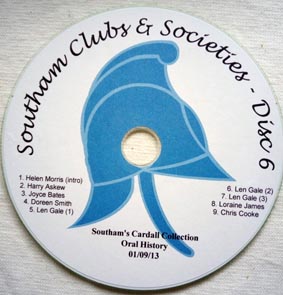Southam’s Oral History Recordings
In 2007, shortly after joining the Friends of the Cardall Collection, I volunteered to work on collecting oral history – that is, recording spoken historical memories. It is one of the best ways of finding out about recent local history. Some of those early contributors have now sadly passed away but at least we have recordings of their unique memories of Southam.
We formed a small sub-committee and did some initial research. The first advice we received was to get a Maranz recorder, but this was an expensive, large and heavy item, so I went to a Sony shop where a young assistant sold me a state-of-the-art solid state recorder and a tiny tie-pin microphone. After some experimentation, two of us were willing to give it a try, and started to learn more.
There were several processes to be mastered alongside the recording techniques. These included contacting possible interviewees, photographing them, collecting their details, transcribing the recordings, scrutinizing the results, transferring the recordings to CDs and computers and storing the material collected. The Oral History Society ( www.ohs.org.uk ) is much concerned with authenticity – making sure that every nuance is recorded – so even the ‘ums and ahs’ had to be transcribed. There were also warnings about going into strangers’ homes alone. I must say that Mike Hill and I had no worries about that aspect as everyone was most helpful and kind.
Our first interviewee was Mrs Rene Cardall in May 2007. Sadly she died shortly afterwards, still hoping that her precious Cardall Collection could be saved for posterity. Jonathan Russell kindly transcribed the first contributions and Pam McConnell found some proformas online, so that I had a good idea of how to go about writing down the results. I also took advice from Warwick Museum; they suggested making summaries of the recordings with notes of timings and lengths so that material could easily be found later. These have proved to be very useful time-savers when writing subsequent articles and books. With help from one or two IT experts it has also been possible to produce interactive displays and compile and sell CDs in support of the Collection (see photo – CD number 6).
It was a most rewarding and engrossing hobby. I extended my computer skills and met many interesting people. We had a lot of laughs and inevitably, glitches. Some recordings had to be done twice as there were unexpected interruptions from pets and other surprises, and some people requested that parts of what they had said be deleted as they had ‘got carried away’! Everyone gave formal written permission for their interviews to be made publicly available, so no embarrassment was caused.
People are still using the recordings we produced, but when I moved away from Southam and left the Committee several years ago, the project was shelved. I am pleased to report that since the Collection moved into Tithe Place last Summer, there has been renewed interest in recording spoken memories, and it is hoped to re-start the oral history project this year. Technology has moved on since 2007 and recording both audio and video is much simpler now. There are plenty more potential contributors to the on-going history of Southam, which never stops being made.
If you would like to get involved in local history projects, please contact Southam Heritage Collection. We are based in the entrance of Tithe Place on High Street, and are open on Tuesday, Friday and Saturday mornings from 10am to 12 noon. Please see our website www.southamheritage.org for more information. Contact: 01926 613503 email southamheritage@hotmail.com and find us on Facebook.


Leave A Comment